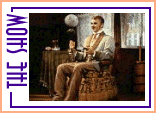 |
 |
 |
 The history of Walt
Disney's Carousel of Progress starts
in the early 60's when many companies were preparing for
the World's Fair in New York City in 1964 and 1965.
The Walt Disney Company, then known as WED Enterprises
(Walter Elias Disney) was hired by several companies,
Ford and Pepsi among them, to design and create exhibits
to boldly represent their respective corporations.
None, however, so grabbed the founder's heartstrings like
the exhibit he was hired to produce for General
Electric. Progressland's Carousel Theater would
be a completely new experience for Walt, and a challenge
he couldn't wait to throw himself into. The history of Walt
Disney's Carousel of Progress starts
in the early 60's when many companies were preparing for
the World's Fair in New York City in 1964 and 1965.
The Walt Disney Company, then known as WED Enterprises
(Walter Elias Disney) was hired by several companies,
Ford and Pepsi among them, to design and create exhibits
to boldly represent their respective corporations.
None, however, so grabbed the founder's heartstrings like
the exhibit he was hired to produce for General
Electric. Progressland's Carousel Theater would
be a completely new experience for Walt, and a challenge
he couldn't wait to throw himself into. Walt immersed himself in the project, even choosing the voices for the show personally, to make sure that the characters reflected the midwestern values and attitudes that he felt so strongly about. (The voices of the father, both chosen by Walt, were Rex Allen and author/actor Jean Shepherd. Most people remember him as the writer and narrator of the movie "A Christmas Story.") Trying his hardest to let the engineers do the work, he took every opportunity to make his point ever so clear about what story the show should convey. "When we were designing the thing, Walt couldn't resist getting up and doing the work himself," explains imagineer, John Hench. "He jumped in the bathtub for the Cousin that was visiting--the guy who invented air conditioning with the fan and block of ice. And he'd say, `What would Cousin Orville do if he were in here?' Walt turned the tub around to face the audience, and he took off his shoes and wiggled his toes to show us. He went through the whole bit. He did several of the acts and even vented dialogue as he went. He was the best storyman, particularly on the small bits of business, and it's the small individual things that you never forget." (Persistence of Vision Publishing) Of all of the exhibits that came to fruition, the Carousel Theater was by far the fan-favorite. It is, in fact, often remembered as the G.E. pavilion. In reality, there were five different sections to the presentation, including Fusion on Earth and Electric Living - an on display electric community.
|
| Comments? | |
©2000
Ladder Productions |